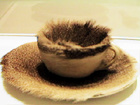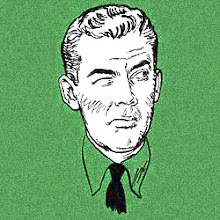 UbuWeb Films features several shorts by Shirley Clarke (1919-1997), including A Scary Time of 1960. Music by Peggy Glanville-Hicks, produced by UNICEF (yes) in consultation with Thorold Dickinson. Go to Ubu's Clarke page and you'll find several of her shorts combined into one video.
UbuWeb Films features several shorts by Shirley Clarke (1919-1997), including A Scary Time of 1960. Music by Peggy Glanville-Hicks, produced by UNICEF (yes) in consultation with Thorold Dickinson. Go to Ubu's Clarke page and you'll find several of her shorts combined into one video.Clarke studied filmmaking with Hans Richter at the City College of New York after making In Paris Parks (1954). In 1955 she became a member of the Independent Filmmakers of America. She became part of a circle of independent filmmakers in Greenwich Village such as Maya Deren, Stan Brakhage, and Jonas Mekas.
Her 1963 film was The Cool World & Robert Frost: A Lover's Quarrel with the World.
Clarke also directed a 90-minute Cinéma vérité interview with a black homosexual titled Portrait of Jason (1967), which has been called an insightful exploration of one "persons character while it simultaneously addresses the range and limitations of cinema-verité style." -- Lauren Rabinovitz. She created the 90-minute film from twelve hours of interview footage. It was distributed by the Film-Makers Distribution Center, which was co-founded by Clarke in 1966, closing in 1970 due to a lack of funds.
In 1970, she formed the T.P. Videospace Troupe, a loose collective working in experimental video and theater.

 Is '60 the moment when the end of the end of the Old Left had been reached and the New Left began to emerge? Is it the final ascendancy, in certain scenes at least, of poetic postmodernity? Surely the publication of Donald Allen's The New American Poetry that year suggests this, but then again--once again--we look back on "New" here and see continuity. The rhetoric of the Kennedy-Nixon contest made much less of a dent than everyone (at the time as well as since) claimed, so one wonders why were such great claims made?
Is '60 the moment when the end of the end of the Old Left had been reached and the New Left began to emerge? Is it the final ascendancy, in certain scenes at least, of poetic postmodernity? Surely the publication of Donald Allen's The New American Poetry that year suggests this, but then again--once again--we look back on "New" here and see continuity. The rhetoric of the Kennedy-Nixon contest made much less of a dent than everyone (at the time as well as since) claimed, so one wonders why were such great claims made?  Had we come to expect "1960" to be truly ubiquitously modern in a way that the 1950s really were not--not quite? And what specifically does "modern" mean in the Kennedyesque talk then and now about the torch being passed to a new generation, etc.? The First Lady really meant "modernist" when Camelotians said "modern." What about the others across the new young cultural leadership? I've been surprised by how frequently the
Had we come to expect "1960" to be truly ubiquitously modern in a way that the 1950s really were not--not quite? And what specifically does "modern" mean in the Kennedyesque talk then and now about the torch being passed to a new generation, etc.? The First Lady really meant "modernist" when Camelotians said "modern." What about the others across the new young cultural leadership? I've been surprised by how frequently the  "Beat movement" was covered in 1960 in the mainstream press. I was expecting a fair measure but I've found tonnage. 1960 was the year when the figure of the beat was beginning to find acceptance, although still 80% of these stories are mocking, rebels-without-cause condescension. For anyone whose analysis made an impact nationally, do these antipolitical adolescents count as part of the "new young cultural leadership"? No, but rather than the two being opposites, they fall along a Continuum of the New American. Now that's a change for '60.
"Beat movement" was covered in 1960 in the mainstream press. I was expecting a fair measure but I've found tonnage. 1960 was the year when the figure of the beat was beginning to find acceptance, although still 80% of these stories are mocking, rebels-without-cause condescension. For anyone whose analysis made an impact nationally, do these antipolitical adolescents count as part of the "new young cultural leadership"? No, but rather than the two being opposites, they fall along a Continuum of the New American. Now that's a change for '60.







